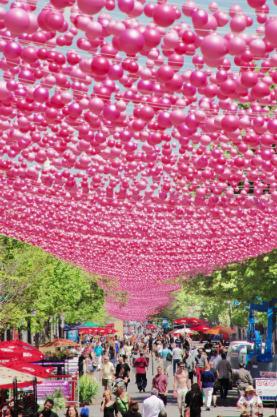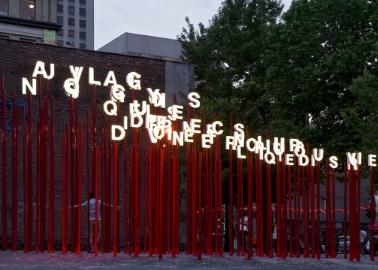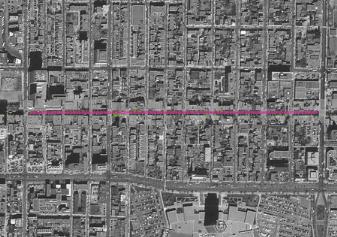
170,000 little pink balls dangle above Montreal's Saint Catherine Street. Credit: Marc Cramer

Guy Corriveau's Le Manifeste states, "A time will come when you can express yourself freely." Credit: Pierre Belanger
Saint Catherine Street East is now about as grey as any other street in Montreal.
But for most of the summer it was the bustling, pedestrian-only heart of the city’s gay village. Throngs of people moved through the east-end street; 170,000 little pink balls dangled above; terraces reached into the road; and giant public art installations lined the street.
It’s all part of the city of Montreal’s attempt to bring a little life into the Village.
The project, having just wrapped up its fifth summer in a row, is called Aires Libres, or Open Spaces. Spanning the length of the Village — which, at 1.2 kilometres, is Canada’s largest gay strip — the project is really hitting its stride.
“It took us three years to find our way,” says Denis Brossard, president of the Board of Administration for the Société de Développement Commercial du Village. “Now we want to bring it forward with the support of the community, the business community and the City of Montreal.”
The project is a marriage of business, art, tourism and partying.
“We decided to use that as a tool to create something different for Montreal, something that didn’t already exist and could express [our] concern for public art and the quality of life,” Brossard says.
“It’s the best thing that could have happened to the Village,” says Guy Payatte, who is the manager and co-owner of The Drugstore, the Village’s most popular lesbian bar. “The sad part is when they reopen [the street].”
Permanent art installations dot the strip, offering showcases for some of Montreal’s premier visual artists. One, dubbed Mémorama, is a series of massive photo booths that allow Village-goers to have their pictures taken – they’re posted directly to the Mémorama blog – and take in the view of the Village from above. Then there’s Montréal Complètement Cirque, which aims to take a public circus to different parts of the city. In addition, it occupies part of the Village during its 10-day run.
There are a series of photo exhibits, statues and stands that line the busy tourist attraction.
One installation, realized during last year’s run, has become a permanent fixture of the Village due to its immediate popularity. Le Manifeste, referring to Guy Corriveau’s Village Manifesto, is a message that can be read only from a specific angle. “A time will come when you can express yourself freely,” it reads when the illuminated letters align.
The idea, Brossard says, is to create a kilometre-long “stage” for artists.
The signature for Aires Libres has become the Village’s trademark boules roses, which hang overhead – varying in angle, density and consistency on different parts of the street to convey different motifs. The concept came from local urban designer Claude Cormier. “What better than 170,000 pink balls suspended high in the air to enliven Montreal’s Sainte-Catherine Street East as it transforms for the summer into a pedestrian mall?” his website asks.
“The pink balls are our new image,” Payette says.
The Village is already looking forward to the next five years, with plans to invite artists from all over the world to come and showcase their creativity in Montreal. The aim is to put the city on “an international level,” Brossard says.
What’s good for the arts, it seems, it also good for business. Brossard says that the vacancy rate for storefronts on the street plunged from 22 percent to eight percent in the past year and a half.
Payette backs that up. “Business gets better on the first day the street gets closed,” he says, adding that the business that follows for the next two weeks is “incredible.”
When the city shortened the length of the project this year, businesses, residents and the gay community all came together to voice their displeasure.
Just about every bar or restaurant worth its salt on the street also has a terrace or patio reaching out into the street. A usual Friday night in the Village entails the massive terrace of the mutli-level Sky Club teeming with people, a throng of men in leather chaps leaning over the wooden patio at L’Aigle Noir, and a gaggle of drag queens smoking outside the famous Cabaret Mado, sometimes even Mado herself.
During the daytime there are street carnivals, outdoor concerts, and — for much of this summer — one of the infamous manifestations of protesting students. The car-less street also plays host, at least in part, to myriad summer festivals, including the three main Pride festivals: Fierté, Divers/Cité and the raunchier, more radical Pervers/Cité.
Francois Robillard, the Vision Montreal councillor for the district who sits in the opposition benches in city hall, points to some areas where things can be improved, particularly the high rate of petty crime in the Village. He says, also, that more can be done to improve the installations and terraces in the area, to create a higher quality experience and improve circulation.
For Payette, the biggest problem is the homelessness that plagues the Village all year round. “Nobody cares about them. The city doesn’t care,” he says. He calls it “the only sad part of the Village.”
While some improvements may be in order, Brossard says that Aires Libres is here to stay. “In five years, Montreal will celebrate its 375th anniversary, and we intend to be part of the celebration.“


 Why you can trust Xtra
Why you can trust Xtra


